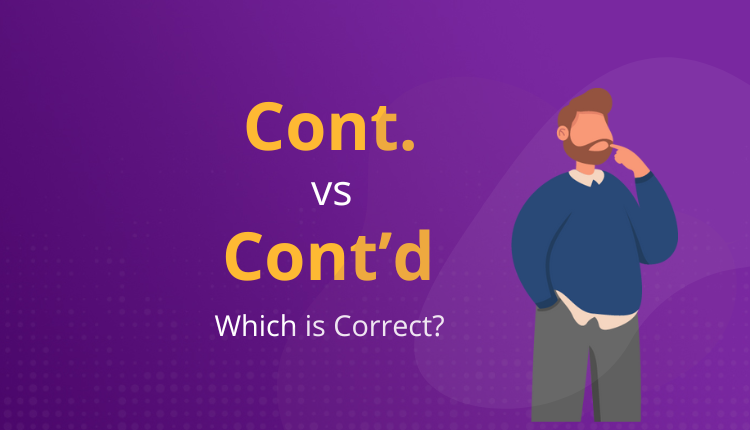The writing world is full of subtleties, particularly in the matter of abbreviations. One word that tends to raise eye brows is “continued.” You may have seen its short forms, such as “cont.” and “cont’d,” but do you know which to use? This seemingly trivial piece of information can make a huge difference in clarity and professionalism.
Whether you’re writing a report, writing an article, or simply attempting to get your point across clearly, it’s crucial to know the right continued abbreviation. Let’s explore this subject and dispel any confusion about these everyday terms!
What Does “Continued” Mean?
The word “continued” usually describes something that is continuing or has not yet completed. It carries a connotation of persistence, whether in writing, dialogue, or endeavors.
In most contexts, it is an indication that information will be continued later or picked up another time. For instance, you may find “continued” appearing in articles where discussions are prolonged across several pages.
This seemingly innocuous word has significance and meaning in numerous areas such as journalism, academics, and business communications. Having an understanding of its implications can enhance clarity when communicating effectively.
Abbreviating “Continued”: Common Forms
Shortening “continued” can make your writing more concise. The two most widely used forms you will find are “cont.” and “cont’d.” Each serves its purpose based on circumstances.
“Cont.” usually appears in formal documents like reports or scholarly papers. It is a simple abbreviation that is professional without being showy.
In contrast, “cont’d” uses an apostrophe to represent the missing letters. This abbreviation is common in dialogue or other informal writing where concision is important but clarity cannot be compromised. By knowing these differences, you are in a better position to select the appropriate abbreviation for your use and your audience.
Key Differences Between “Cont.” and “Cont’d”
The key differences between “Cont.” and “Cont’d” lie in their usage and meaning. “Cont.” is a straightforward abbreviation for the word “continued.” It’s often seen in tables, lists, or academic contexts where space is limited.
On the other hand, “Cont’d” represents a contraction of “continued,” indicating that there’s more to come. This form retains an apostrophe to signify omitted letters, specifically the ‘i’ and ‘u.’
Knowing these differences can make your writing clearer. The correct choice depends on context—whether you need conciseness or want to preserve stylistic consistency in your writing.
Which Abbreviation Is Correct?
As far as the continued abbreviation is concerned, both “cont.” and “cont’d” are widely accepted. The context, however, makes a difference. The decision usually depends on the style of your writing.
In informal or social environments, “cont.” is very common and easily comprehensible. This form is easy going and simple when space is scarce.
Conversely, “cont’d” looks more refined in formal papers. It still has a hint of class without revealing that something is continuing. Choosing between these two is based on your readership and intended use for clear communication.
Common Errors and Misconceptions About continued Abbreviation
Most people inaccurately assume that “cont.” is the proper abbreviation for “continued.” Though widely practiced, it’s not the only alternative. Such misinformation may create disarray in professional writing.
The second frequent mistake is using “cont’d” improperly. Other authors add more letters or punctuations, deviating from its typical structure. This might reflect sloppiness and can make the document appear less professional.
Some think the two forms are interchangeable across every situation. However, usage could differ due to stylistic purposes or publishing instructions. Awareness of these differences may improve the quality of your writing and prevent traps with further abbreviation.
Trinka Grammar Checker is an advanced, AI-powered writing assistant designed for anyone looking to improve their writing skills. Its advanced algorithms effectively identify and correct grammar errors, ensuring your message is clear and accurate.
As for abbreviations such as “cont.” or “cont’d,” Trinka can give you context-specific recommendations that refine your content. This is particularly beneficial for professional and academic content.
Apart from context-specific recommendations, Trinka also gives real-time feedback, meaning you get to view corrections in real time. This real-time assistance enables you to learn from your errors while refining your language skills overall. With Trinka, it is much easier to master the subtleties of continued abbreviation.
Conclusion
Knowing the ongoing abbreviation can improve your writing clarity. Whether to use “cont.” or “cont’d” might appear insignificant, but it is important in professional writing. Knowing when to use each variation helps you steer clear of typical errors that divert readers’ attention.
Utilizing tools like Trinka Grammar Checker ensures that your writing remains polished and error-free. So whether you’re drafting a report or penning an article, being mindful of abbreviations will elevate your work’s quality and professionalism. Embrace these tips for effective communication!

